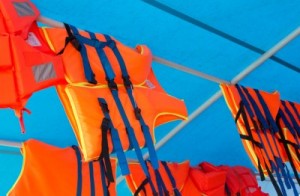 Anyone who owns a boat and respects the rules of the water knows that having a life jacket for all passengers onboard is the law. Simply wearing a life jacket is not enough – anyone putting on a jacket should make sure that it fits properly and the straps, buckles or zipper are secure. There are many types of life jackets designed for specific boating and water activities.
Anyone who owns a boat and respects the rules of the water knows that having a life jacket for all passengers onboard is the law. Simply wearing a life jacket is not enough – anyone putting on a jacket should make sure that it fits properly and the straps, buckles or zipper are secure. There are many types of life jackets designed for specific boating and water activities.
The offshore life jacket is designed for extended survival in rough, open water. It usually will turn an unconscious person face up and has over 22 pounds of buoyancy. This is the best floating device to keep you afloat in remote areas where rescue might be slow. Near shore buoyant vests come in several sizes for adults and children and are needed for calm inland water where there is a chance of rapid rescue. They are less bulky and less expensive than offshore life jackets. A life jacket that is classified as a flotation is considered to be the most comfortable. The styles accommodate different boating activities and sports. They are for use in calm water where there is good chance of fast rescue since they will generally not turn an unconscious person face-up. Flotation aids come in many sizes and styles. Special use devices include work vests, deck suits, and hybrids for restricted us. Hybrid vests contain some internal buoyancy and are inflatable to provide additional flotation. There are also inflatable life jackets that are highly visible when inflated and turns most wearers who are unconscious face up faster than the traditional floating device.
For optimal protection it is imperative for the life jacket to fit properly. A proper fit means once it’s zippered and/or buckled, it should keep your head and upper shoulders above the water. If it fits too loose, the flotation will push the jacket up around your face. If your life jacket is too small, it won’t keep your body afloat. When not using your life jacket, store it in a readily accessible place away from sunlight and chemicals. Nylon and other synthetic materials used to make your life jacket will be harmed over time by ultra-violet radiation from the sun. Fabric that becomes discolored may indicate ultra-violet damage. In other words, don’t leave your PFD hanging outside all summer exposed to the sun and expect it to be unharmed. Also, prolonged exposure to chemicals or exhaust fumes can attack the flotation’s foam.
Boaters enjoy the feel of sun and spray so it’s tempting to boat without wearing a life jacket – especially on nice days, but life jackets come in all shapes and sizes so there is no excuse for being without one.
Source: “Types of Life Jackets.” Types of Life Jackets. Web. 17 July 2013.
Follow Us: Facebook – Foursquare – Twitter – YouTube – LinkedIn
